On May 1, 2017, thousands of Puerto Ricans rallied along the Avenida Ponce de León to protest the Ricardo Roselló administration and the Financial Oversight and Management Board. It was El Paro Nacional, a day of national protest. A procession of marchers with signs, banners, and other protest paraphernalia into a bank of tear gas, batons, and media puppetry.1 One year later, on May Day 2018, demonstrators still reeling from Hurricane Maria and calling for governmental reform—especially in response to the administration’s plan to destabilize the public education system with the creation of charter and voucher systems, the closing of more than two hundred public schools, and the layoffs of more than three thousand educators—were again met with organized state violence. Peaceful stands for equity were challenged by La Fuerza de Choque, or “the strike force”—the Tactical Operations Unit of the Puerto Rico police, which is routinely used to regulate large public gatherings and protests.
This is how the state maintains its power.2 The escalation of violence on Avenida Ponce de León between protesters, the essential subjects of the undercommons or the hyper-public actors of state critique, and La Fuerza de Choque is normative across the island. Similar forceful episodes unfolded in 2010 with the student strikes at the University of Puerto Rico, the Puerto Rico Telephone Company strike of 1998 in Guaynabo, and the protests in Vieques against the United States Navy in 1999 and 2000. In Puerto Rico, public resistance and refusal has been systematically met with an order of retaliation long condemned for its pattern of civil rights violations. This is, perhaps, not surprising; this is the United States, a land invested in the preservation of racialized economic, labor, and cultural systems. However, this cycle of public protest and state abuse also represents the unyielding weight of Puerto Rico’s colonial history and its status as a test bed for the US’s abusive expansionist policies.
As seen across the Caribbean, San Juan is a landscape of imperial possession. The Avenida Ponce de León, the seven-mile thoroughfare extending through the entire municipality of the city, is no stranger to violence. Its name, honoring Juan Ponce de León, is synonymous with violence as well. Ponce de León was the first governor of Puerto Rico under the Spanish crown and a lead figure in the genocide of the Taino natives. His home still stands in Guaynabo today, a municipality west of San Juan, one of many markers of his presence in the country. As such, Spanish occupation and colonial rule lives in the architectural vernacular of the island. Its landscape is generated by military and defense:
The first maps of San Juan reveal in drawing and notations a city dedicated to spiritual and military conquest, to God and gold, from its two morros with their massive fortifications, to the cathedral, and two chapels, one dedicated to the patron saint of artillery, St. Barbara, and one to the guardian of soldiers, St. Sebastian. For four hundred years, San Juan continued to be a military fortress that dictated an architecture of discipline and severity.3
With US occupation in 1898 came a shift in the island’s cultural and political architectural expression. American-funded development—seen most visibly in the early hotels, schools, public spaces, and government buildings built at the turn of the twentieth century—materialized the West’s imaginative fiction of the tropics and Spanish cultural fabrics through imperialist “frontier” and “revival” styles. Although these ideas would evolve with American industrial production and local architects, Puerto Rican urbanity was not cultivated around the cultural values of the people who called the land home but around the colonial conditions of tourism and financial investment. Architecture functioned heavily in the process of Americanization—securing the island’s position as belonging to but not a part of the United States—marked and remarked through processes of subjugation and partisanship.
The Avenida Ponce de León (also known as Route 25) travels south to north in San Juan, beginning in Río Piedras and running through Hato Rey and Santurce before ending at the Guillermo Estévez bridge to Old San Juan. Although it does not span very long, the avenue illustrates the structural and cultural systems of empire that undergird Puerto Rico’s urban infrastructure. It depicts the conditions of city life in a contemporary western colony. Urban planning under imperialist governance is conditional, building towards a capitalist automation of survival: “Policy is the form that opportunism takes in this environment, as the embrace of the radically extra-economic, political character of command today. It is a demonstration of the will to contingency, the willingness to be made contingent and to make contingent all around you.”4 Positioning the Avenida Ponce de León as an edifice that characterizes the socio-structural development of San Juan, we can read the country’s built environment and its undercommons—the productivity, subversion, and critique, of both the commons and the state. It is a journey that invites inquiry into the structural interiors of the city and the communities who live there.
As we take a walk along the Avenida Ponce de León, the frail facility of ethical and equitable provisions across the territory, prior to and in the aftermath of Hurricane Maria, comes into focus. Embedded in the groundwork of the city is the tension between possession and absence, memory and vacancy. San Juan, and the country as a whole, is beholden to the coming tide of what’s bubbling beneath the surface: the future of economic and infrastructural redevelopment, mass resistance, and migratory patterns out of the country. This essay is not a deconstructed tour but a meditative account of the neglected sites of urban occupation and the colonial trappings of a territory marked for sale.
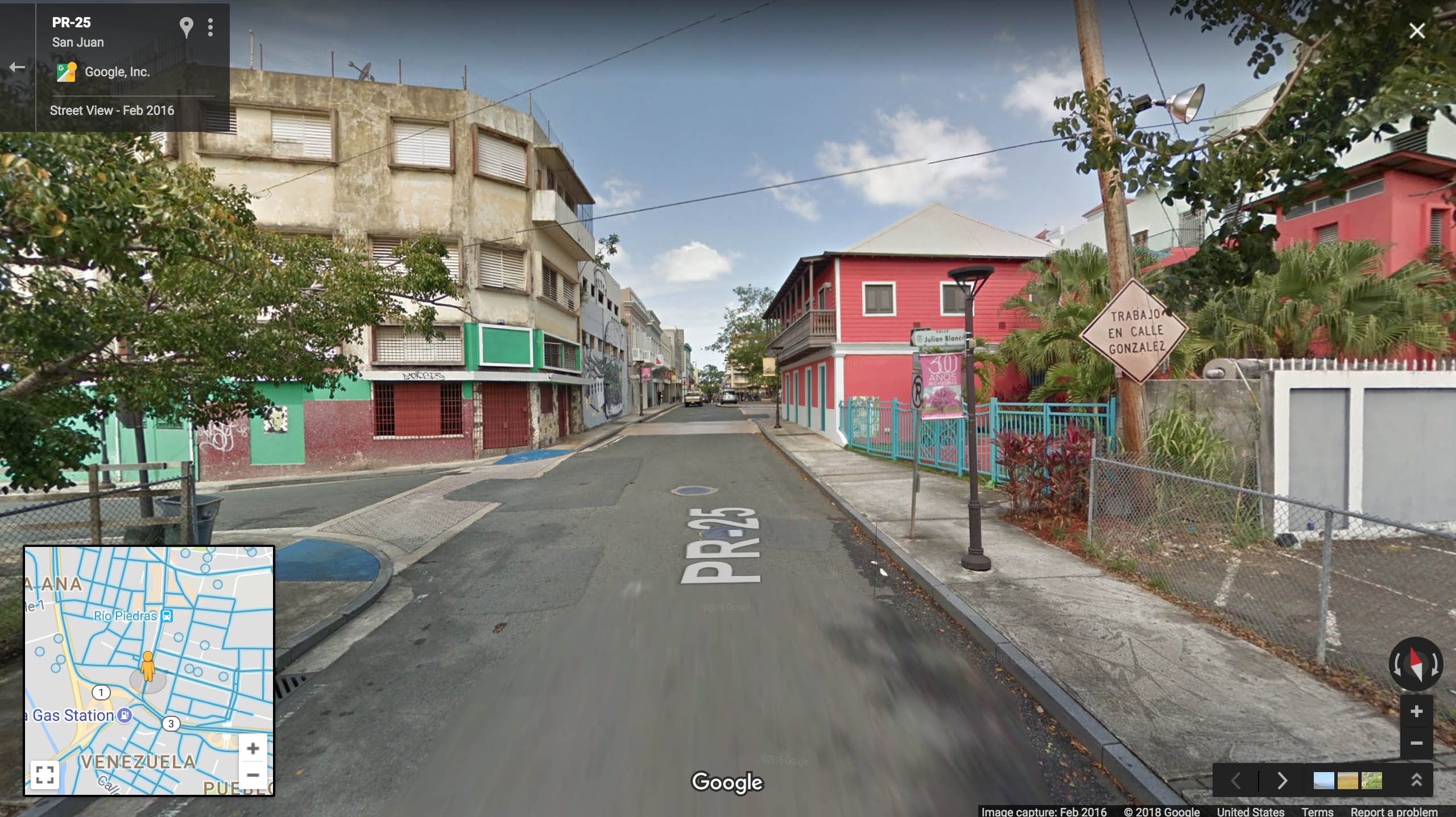
Río Piedras
The Avenida Ponce de León begins in Río Piedras about seven hundred meters before the University of Puerto Rico (UPR), the capital of education and knowledge on the island, and in front of the Ruth Hernández Culture House, a meeting place for artists offering free community art workshops. Next door is the Iglesia Nuestra Señora del Pilar (Church of Our Lady of Pilar), built in 1931 and designed by Puerto Rican architect Francisco Porrata Doria. Across the street is an active train station completed in 2004, coupled with abandoned buildings on both sides, like the old historic Singer manufacturing storefront now dormant with real estate banners and rotten inventory in the windows. This corridor is called the Plaza de la Convalecencia, and it is home to wily wanderers in pursuit of idle vocations. Similarly, all along the Avenida de Diego, perpendicular to the Avenida Ponce de León, buildings have settled into their shadows, with broken windows and crumbling exteriors. This area once hosted one of the largest open-air markets in the northeast of the island, the Paseo de Diego. 5 Now, it, too, has settled into the shadow of UPR—the faint pastels of the buildings and closed iron gates emit a lucid nostalgia onto the sidewalks.
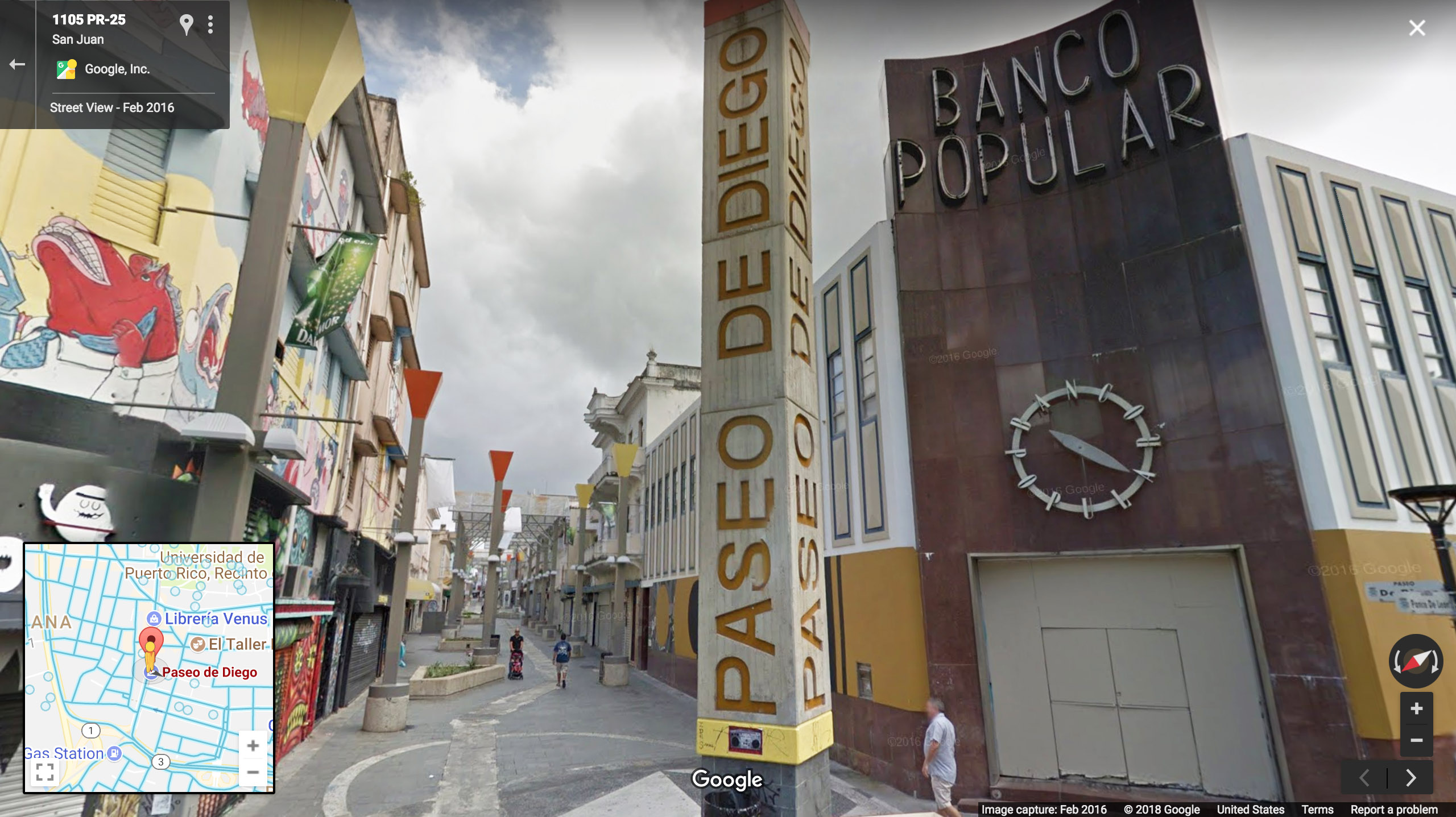
As you approach the campus, the neighborhood becomes more animated with the neon-lit “OPEN” signs of cafeterias, tiny stores, and legal offices. A number of bookstores, bars, thrift shops, and small businesses have forged their foundations around the campus—hoping to attract the students and lifelong learners from across the island, Latin America, and United States that flock here. As with any academic community, this part of Río Piedras is transitory in nature, continually shape shifting due to the university’s patterns of real estate expansion and retraction. This is an area at the behest of university’s ongoing reformation, where site-specific memories fade, evolve, and renew within a single generation.
Río Piedras is also “attractive” for its nightlife. Even those who neither study at the university nor live nearby make their way up and down the Avenida Ponce de León looking for cheap beer and live music. On Thursdays, people head to La Greca, Beckett Theater, Club 77, or any of the other businesses that stay open late offering activities unrelated to their daytime programs—like Bakers, for example, a daytime bakery turned nighttime karaoke disco off the avenue or many of the bookstores that become gallery spaces for literati to present their latest works. One of the most popular stops in all of the Metropolitan area is El Boricua, an establishment that has been there for decades on Calle Saldaña, a narrow two-hundred-meter offshoot off the Avenida Ponce de León. El Boricua is one of many convening sites for students, professors, tourists, and local residents alike. This is part of the spark of Rio Piedras. The neighborhood, via the university, has become a central hub for arts and knowledge production in San Juan, with the vibrancy of economic and social sustainability.
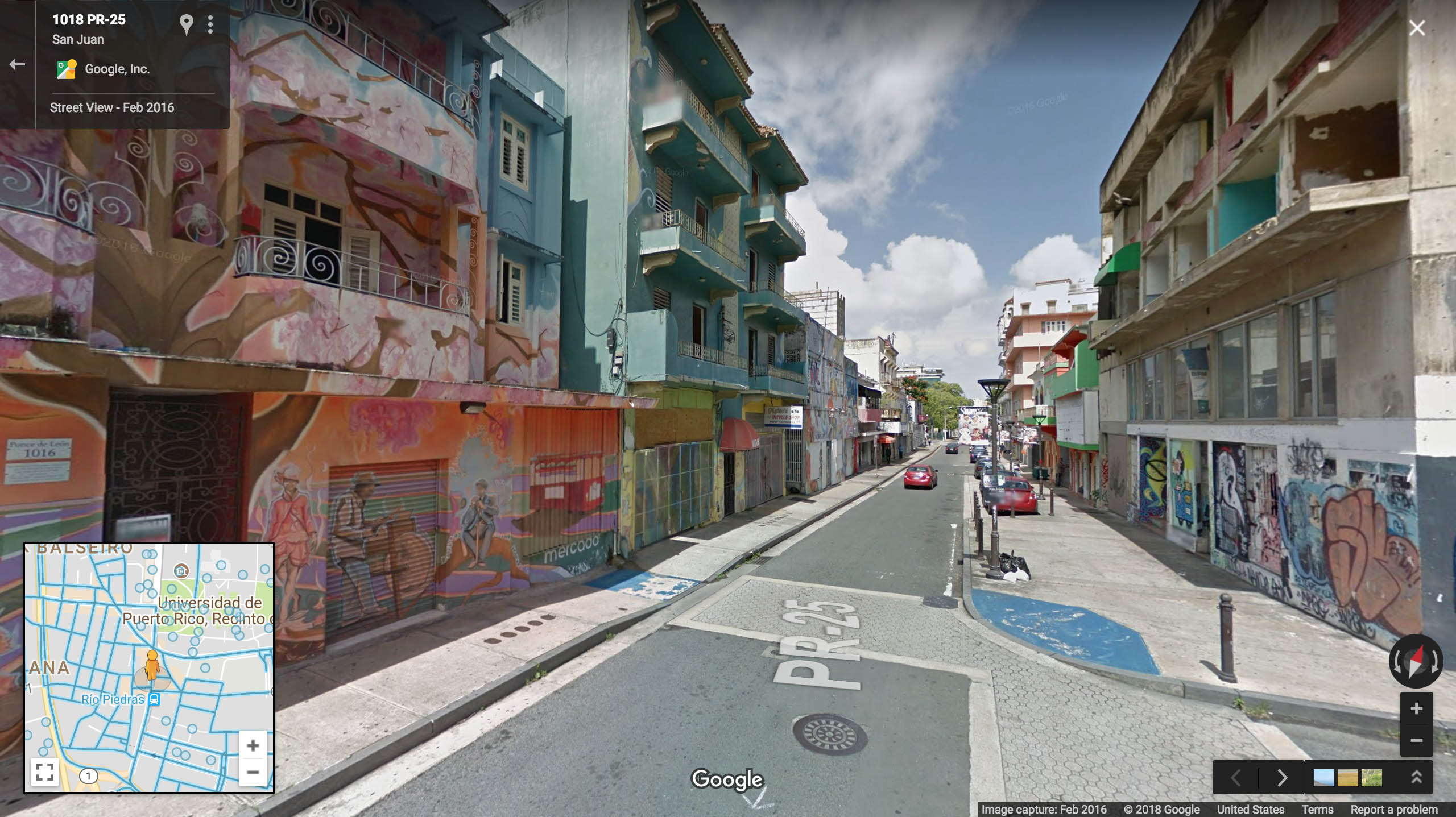
Hato Rey
The end of the UPR campus marks the beginning of the Hato Rey district. At the intersection of Avenida Jesus T. Piñeiro (named after the first and only Puerto Rican governor of the island to be appointed by the federal government) and the Avenida Ponce de León is the Auxilio Mutuo Hospital, one of the island’s leading medical facilities. The hospital originally opened in 1883 in Old San Juan and moved to Santurce in 1899, prior to its current location in Hato Rey. Before the devastating passage of Hurricane Maria, dozens of trees decorated the open areas in front of the hospital. The landscape has since deteriorated; most of its trees have fallen, and many still lie along the lawn waiting to be removed. This is the case of many public service areas after last year’s hurricane season. A new landscape of concrete, glass, and tree rubble has settled in and around buildings throughout the island. Of course, addressing the quality of life in civic and public spaces is low on the schedule of priorities given that several municipalities are still living in the dark, still unreachable, and still without basic services like adequate housing or stable health care. Major intersections are without working streetlights, and freeways are saturated in total darkness come nightfall. However, in this stagnant “low-priority” rubble, we still see the way in which colonial logics determine what is crucial to recover and sustain life.6

Like the lively offshoots in Río Pedras, the residential areas in Hato Rey are located on the small side streets or calles that cross Route 25. From Calle Ponce to Calle Ramón Emeterio Betances and Calle Segundo Ruiz Belvis, most of the surrounding enclaves are composed of low-income households (with the exception of Floral Park). These communities exist alongside, behind, the otherwise economic and financial institutions that line this portion of Avenida Ponce de León. Being the center of economic life on the island, Hato Rey is home to many government buildings like the UBS tower, which holds the offices of the Financial Oversight and Management Board. The most important building, however, is the Department of Labor and Human Resources at the Prudencio Rivera Martínez Building—located between the Avenida Ponce de León and the Avenida Muñoz Rivera. Considering the island’s infrastructural problems and economic plunder, both buildings are focal sites for national protests like the ones manifested on May Day.
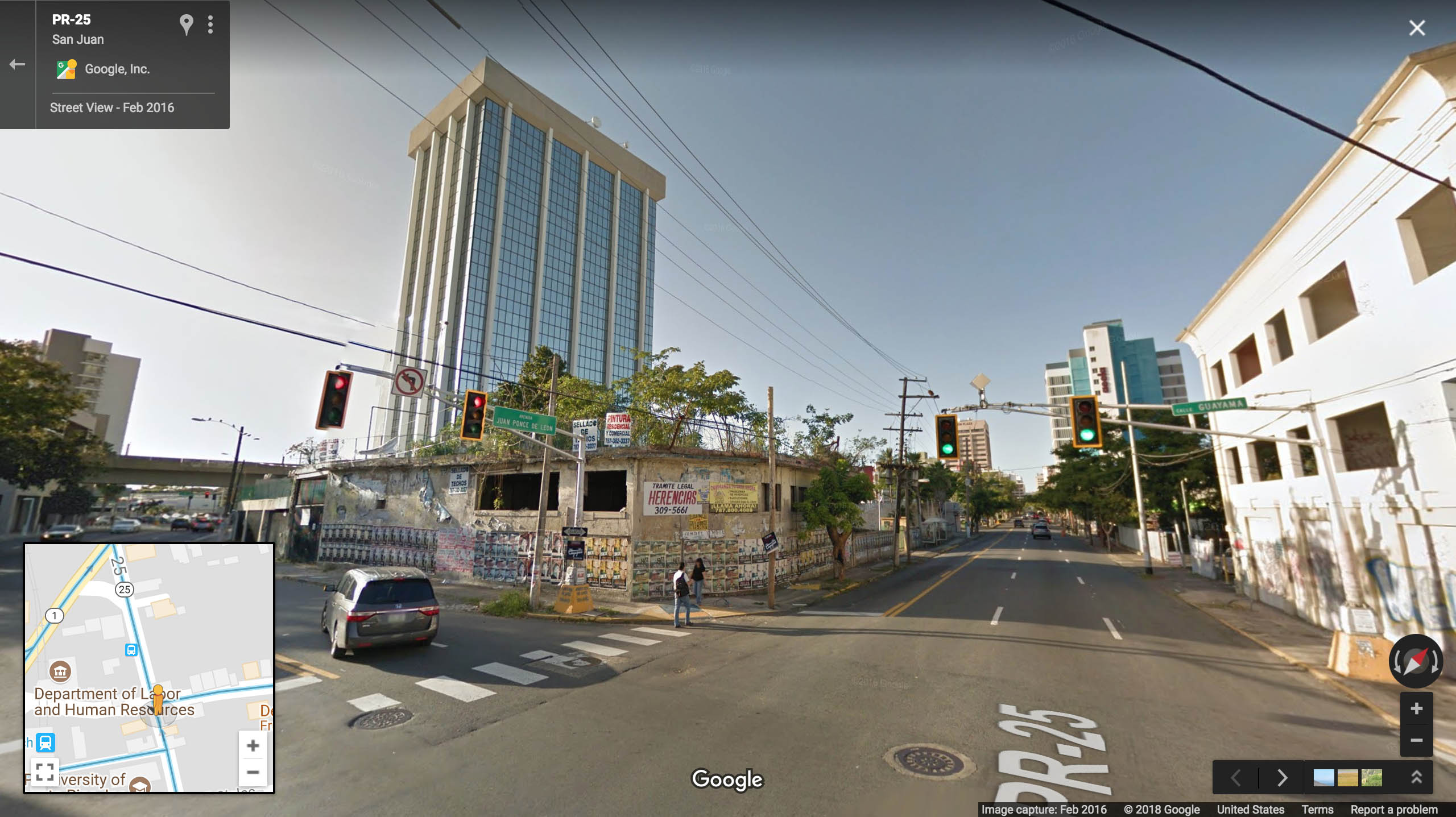
Further north along the avenue are several small educational institutions such as the EDP University and the Liceo de Arte y Tecnología but also the main campus of the Polytechnic University of Puerto Rico. The campus ends at Avenida Franklin Delano Roosevelt, another street that runs perpendicular to the Avenida Ponce de León and that marks the beginning of the Milla de Oro, a dense area of tall buildings, including the PNP (Ricardo Roselló’s Partido Nuevo Progresista party) headquarters, banks, and law firms. Along with the newly erected condo properties that spike up from the otherwise low residential skyline, these offices cast a shadow on the bare and sterile streets below.
Santurce
Santurce begins in the Caño Martín Peña (the Martín Peña Channel), a residential area built in a mangrove swamp. In the 1940s and 1950s, inhabitants of Isla Verde in Carolina, just east of Santurce, were relocated to this city center mangrove, so that their land could be redeveloped into what is now one of the wealthiest places in the Metropolitan Area. The first, and more “lucky,” citizens to be relocated were able to forge their houses on higher ground, while later settlers had to rebuild on the murky banks of the swamp. This is a structural imprint of Puerto Rican poverty, poetically explicated by José Luis González (1926–1996) in his short story “En el fondo del caño hay un negrito” (“At the bottom of the channel there is a black boy”).7 The story chronicles a day in the life of a family in the channel in the 1950s, revealing the nuanced social and racial strata between wet and dry land inhabitants. In it, two neighbors that live on solid ground discuss the poor black family that lives along the water, or those “who have to throw themselves into the water, as they say.” In the end, the family’s young boy does indeed plunge himself into the water overcome with hunger and a desire to play with his own smiling reflection in it—drowning his hunger and isolation in the inky distortion of rescue and relief.
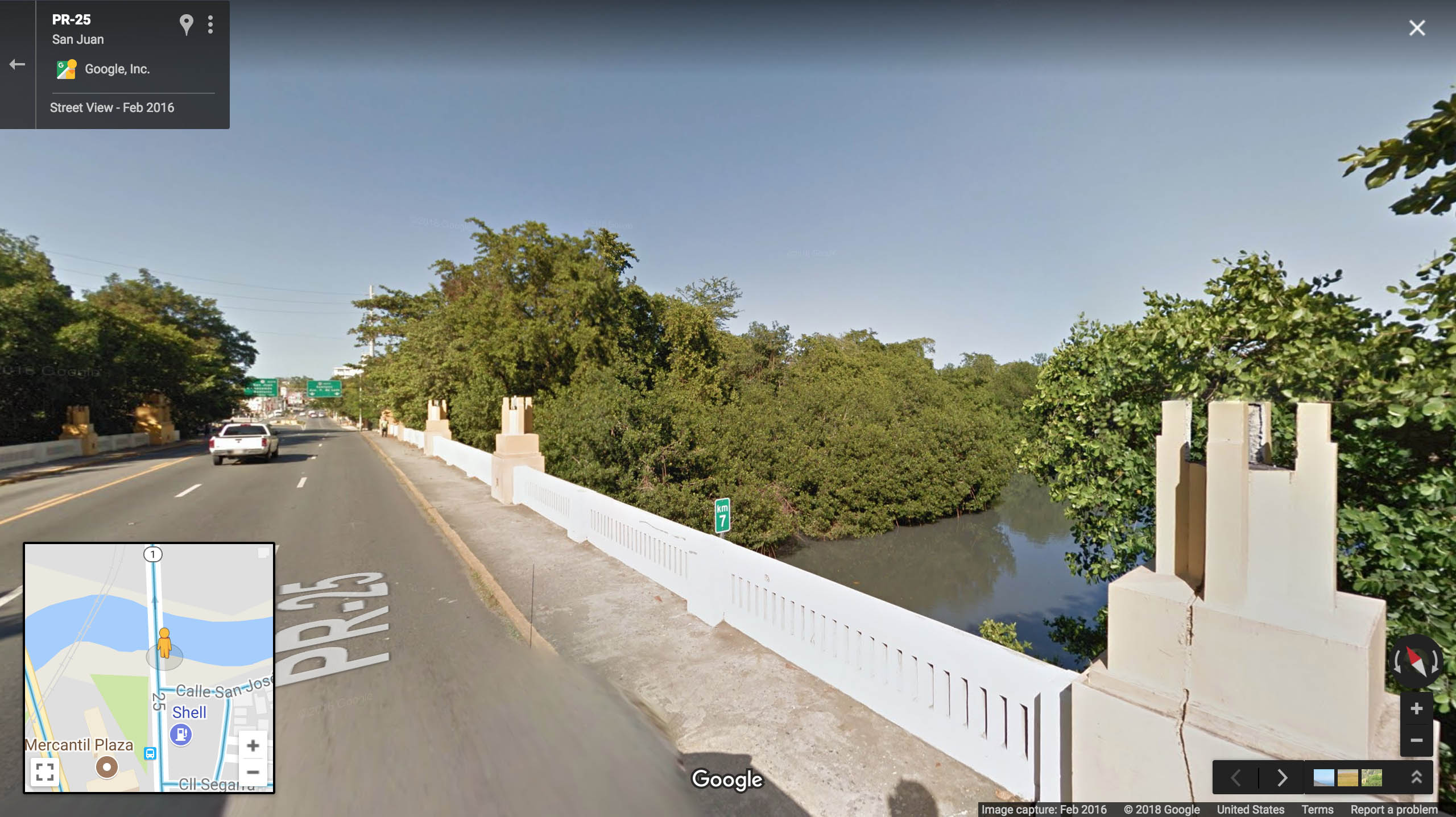
Today, the residents of the channel are still immersed in poverty. While the Universidad del Sagrado Corazón—one of the oldest and largest educational institutions in Puerto Rico—is just past the channel, many of the buildings neighboring it are now abandoned and, like in Río Piedras, are canvases for graffiti. Pedestrian walkways are tattered; few businesses have flourished there since the 1970s and 1980s, all succumbing to the economic crisis, spiked rents, and environmental disasters. Only a few of the businesses that faced Hurricane Maria have reopened; foreign ones have, mostly, used the devastation as an excuse to desert the country’s economic landscape. That said, even with the blows of economic sprawl, Santurce, by day, has slowly become an ideal place for new art and cultural production, a community where old and new familiars, from businesses to street vendors, are on steady rotation.
Between the vacant properties are small regional banks and young DIY multipurpose galleries that hold the pulse of regeneration throughout the neighborhood. During the night, a large part of this area becomes dark and desolate, except for the quiet scurry to and from strip clubs and rare local pubs. Most of the cars that use this part of the Avenida Ponce de León are en route to Miramar or Old San Juan.
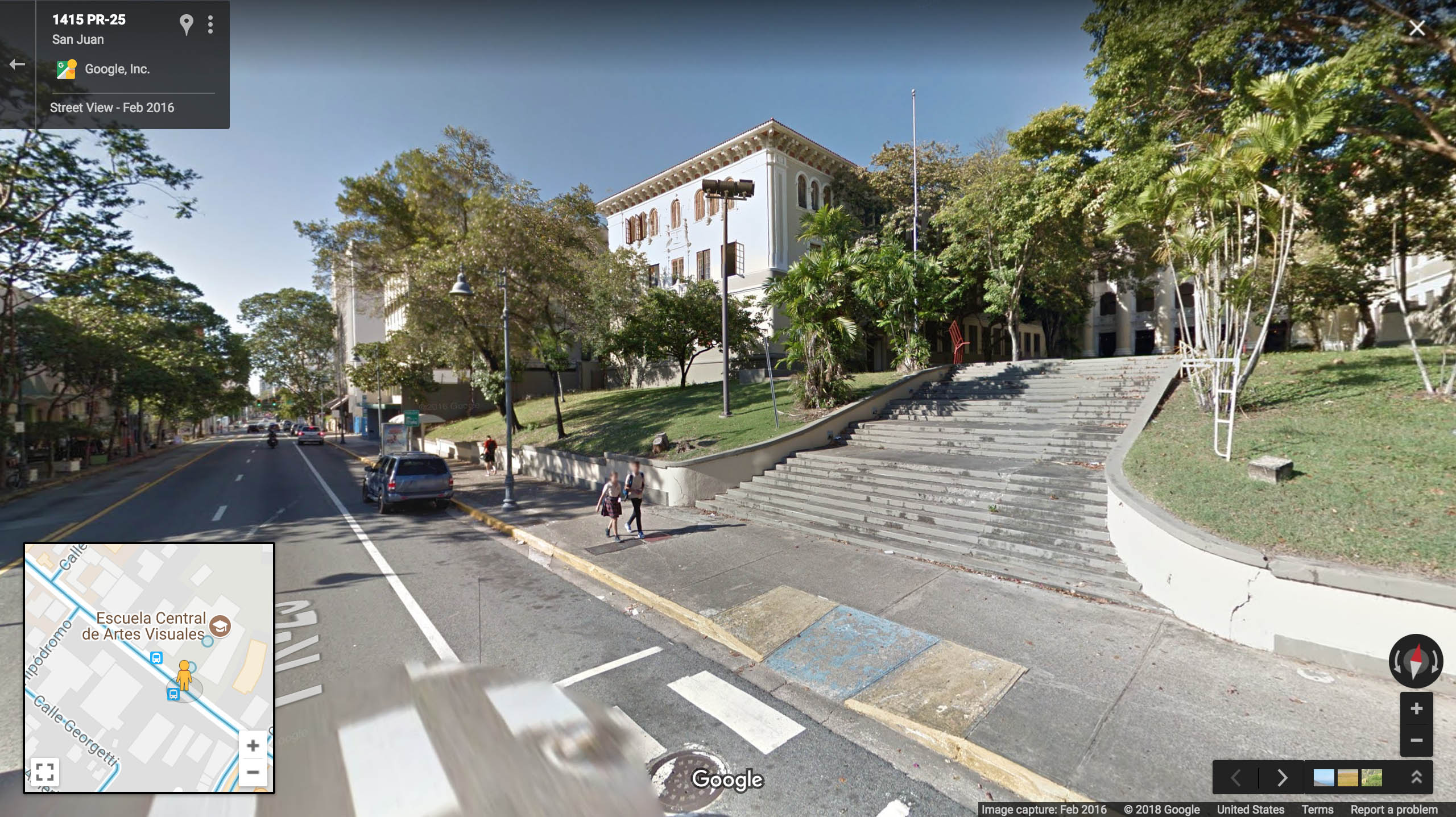
Before arriving at Miramar—the last district that Route 25 traverses through to Old San Juan—you cross Central High School, a public institution specializing in visual art, and two important museums on the island: the Museum of Art of Puerto Rico and the Museum of Contemporary Art of Puerto Rico. This is the city’s major arts district. It is here, too, that the Fine Arts Center—a concert hall and staple for music—is located, along with the historic La Placita market plaza off Calle Dos Hermanos. These institutions are representative of the concentrated wealth and capital coming to the neighborhood.
Miramar is one of the most residential areas flanking the Avenida Ponce de León. The range of housing is extreme, as the average cost of a single-family home is around sixty-five thousand dollars and with condos reaching the million-dollar mark, far exceeding the mean income of residents, citywide. In just four hundred meters, Miramar reveals itself to be completely different from Santurce. The sidewalks are adorned with restaurants, cafés, and theaters. The new Conservatory of Music of Puerto Rico moved to Miramar in 2009 from its original location in Hato Rey, aiding in the shift from parades of prostitutes and addicts to huddles of students with their musical instruments dining at food trucks or cafés. As cinemas, grocery stores, and retail spaces line the bottoms of apartment complexes, the stark break in the rugged feel of Santurce can make the area feel a little fictitious.
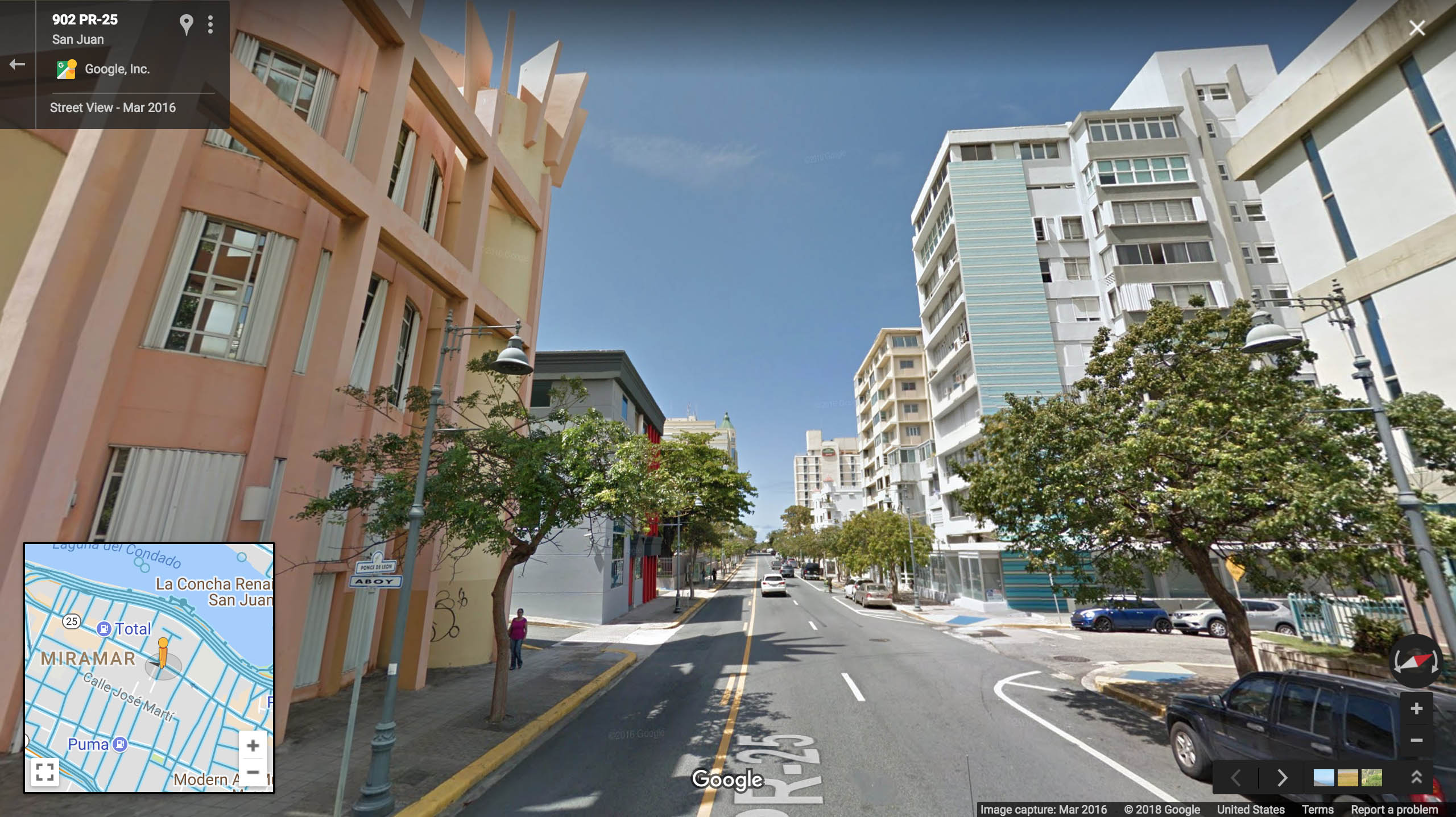
After passing the restaurant Melanzana, what seems like the last venue on Avenida Ponce de León, the route slowly dissolves into the tide of tar that is the Avenida Fernandez Juncos, before crossing over to the isle of Old San Juan, where Route 25 continues but with different names—like Luis Muñoz Rivera Avenue. Although its name changes, the avenue materializes the same urban realities from Old San Juan to Río Piedras: an unstable economy, divested small businesses, stark class divides, and fragile public spaces. Many may describe the Capitolio as a site where civic rights are determined and violated, and state criminals do what they please.
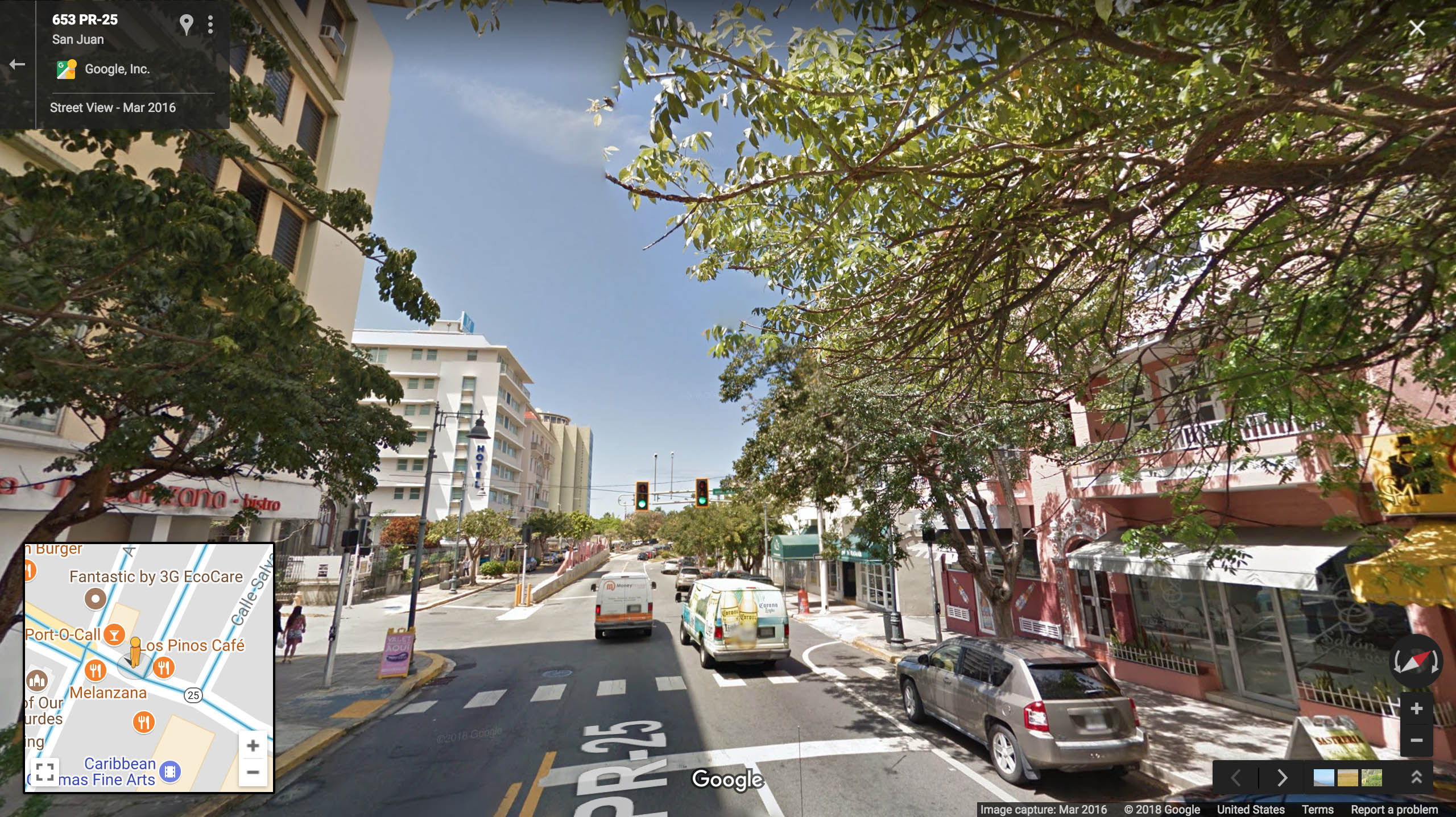
The Undercommons
In relationship to, mainly in friction with, the built environment, there are the citizens of Puerto Rico that make up the commons and the underground. They are cast as the wanderers of the city, the unmeasured public figures who shape and embody the locality of the place, reflecting the wavering functionality and failures of the commons. Even the Changos, a black bird native to the island, is colloquially described to having assimilated the behavior of the Boricua, a West Indian bird, describes Magali García Ramis, twinned within the Caribbean conglomerate of the twentieth century: sociable, attacking anyone who crosses its path, and confident in habitats of “disturbia.”8 So what of the wanderer’s shadow? Is it saturated with acts of resistance and complaisance? Is it brought to the light by an impenetrable consumerism and hyper-cultural production? The wanderers are made up of the outdoor homemakers; the public sex workers; the underpaid handymen; the recyclable garbage collectors; the round-the-clock panhandlers and roadside vendors; the thwarted black and youthful loiterers; the street gamers; the targetable docu-tourists; the roaming culture and trouble seekers; the speedy pedestrians and always late public transit commuters; the smiling religious preachers with easels full of universal savior print collateral; the voyeuristic real estate brokers and property flippers; the ancestral drummers and dancers; the public works artists; the morning drunks; the dishonest addicts and daily dealers; the brave-hearted cyclists; the foreign nannies; the jobless mothers; the double-shift parents with latchkey kids; the window shoppers; the elderly and sweet-and-sour caretakers; the sleepless night workers; the unrequited talent of street performers and bar vocalists; the quietly observant poets; the slow-moving retirees; the fast-paced entrepreneurs; the leisurely rich; the boisterous local celebrities; the misdiagnosed mentally ill; the rapping puritans; the art dealers; the relentless job seekers; the lifelong fighters; the blind actors; the state police and politicians; the uninspired truants; the transitional movers and drivers; the reparable hair braiders and barbers; the persevering urban farmers; the marketable lobbyists; the careerist robbers; the slow but steady-paced insurance men; the pyramid schemers; the chess, checker, and domino players; the show-and-tell lovers; the aimless heartbroken; the determined partygoers and cheap bar hoppers; the loudly organized activists, with their thrifted clothing and résumés full of published op-eds; and the students.
These are the people that meander daily along the Avenida Ponce de León: they are the most critical components to the portrait of this seven-mile stretch within the capital. They are the true subjects of this spatial inquiry—the urban dwellers, colonial inhabitants, and citizens still unmarked, untallied, undercounted, and unidentified eight months after Hurricane Maria.9 The undercommons possesses the dialectic of the living veil between death and absence. Whether it surfaces as the delayed insurance of death or the mass migration and evacuation of Puerto Ricans to the United States, the wanderer’s shadow is sunken—devoid of care or rescue. This is the subjective quality of citizenship under a twenty-first-century colony.
-
The story of Nina Droz-Franco exemplifies the skewed underpinnings of the May Day 2017 protest repression. Droz-Franco was arrested during the demonstrations and later charged with conspiracy and the malicious use of fire in an alleged attempt to burn down the Banco Popular de Puerto Rico building. Evidence of the incident was a video showing a piece of paper getting lit on fire near the property. Droz-Franco was later identified as wearing similar clothing to one of the actors in the video and subsequently hurled into the middle of a national political narrative about the violent and terroristic nature of student protests. Federal agents have since confirmed that the Banco Popular was never at risk; however, Droz-Franco still awaits trial. See Department of Justice, US Attorney’s Office, District of Puerto Rico, “Woman Arrested for Use of Arson or Explosives,” press release, May 2, 2017, link. ↩
-
The Puerto Rican police are notorious for organized violence against protesters. Today’s police force performs similarly to the early twentieth century’s “la policía insular” (the insular police department): it still actively creates case files and records of student protesters, denies basic services upon arrest, and practices abuse as a form of restraint. The Ponce and Cerro Maravilla massacres are two historic examples of this violence—revealing the role of the police as abusive agents in the stymieing of peaceful demonstrations. In 1937, a civilian march organized by the Puerto Rican Nationalist Party to celebrate the abolition of slavery and demand freedom for independence movement leader Pedro Albizu Campos ended in bloodshed. The police cornered protesters and opened fire on them. Nineteen people were killed in what would become the Ponce massacre. In the case of Cerro Maravilla, in 1978, Alejandro González Malavé—an undercover agent posing as a member of the Armed Revolutionary Movement—lured student activists Arnaldo Darío Rosado and Carlos Soto Arriví (son of novelist Pedro Juan Soto) into a police ambush, where they were executed. Their murders were a tactic to quell the independence movement. ↩
-
John B. Hertz, “Authenticity, Colonialism, and the Struggle with Modernity,” Journal of Architectural Education, vol. 55, no. 4 (May 2002): 220–227. ↩
-
Fred Moten and Stefano Harney, The Undercommons: Fugitive Planning & Black Study (New York: Minor Compositions, 2013), 77. The rest of the passage reads: “It is a demonstration designed to separate you from others, in the interest of a universality reduced to private property that is not yours, that is the fiction of your own advantage. Opportunism sees no other way, has no alternative, but separates itself by its own vision, its ability to see the future of its own survival in this turmoil against those who cannot imagine surviving in this turmoil (even if they must do so all the time). The ones who survive the brutality of mere survival are said by policy to lack vision, to be stuck in an essentialist way of life, and, in the most extreme cases, to be without interests, on the one hand, and incapable of disinterestedness, on the other. Every utterance of policy, no matter its intent or content, is first and foremost a demonstration of one’s ability to be close to the top in the hierarchy of the post-fordist economy.” ↩
-
Last year, the heightened holiday commercial and consumer crawl bypassed the Paseo De Diego as only seven stores remain open. Frances Rosario, “Desalentador el panorama para el Paseo De Diego,” El Nuevo Dia, December 20, 2017, link. ↩
-
As of April, approximately forty thousand citizens were still without power across the island, making it the largest power outage in US history and second largest in the world. Danica Coto, “Excavator Blamed for Island-Wide Blackout in Puerto Rico,” Associated Press, April 18, 2018, link.
It should be noted that Hurricane Maria only exacerbated Puerto Rico’s existing health care challenges. See Vann R. Newkirk II, “Can Puerto Rico Recover from Maria Before Storm Hits?” the Atlantic, April 26, 2018, link. And recent studies have revealed that increasing mortality rates post-Maria can be attributed to the massive interruption of medical care. See David Blumenthal and Shanoor Seervai, “What Hurricane Maria’s Death Toll Reveals about Health Care in Puerto Rico,” Harvard Business Review, June 7, 2018, link. ↩ -
José Luis González, “En el fondo del caño hay un negrito,” in Todos Los Cuentos (México: UNAM, 1992).
The third time that the black boy Melodia saw the other little boy at the bottom of the channel was at dusk, shortly before the father returned. This time Melodia was smiling before peeking out, and it amazed him that the other was also smiling down there. He returned to doing so with the little hand and the other returned to answer. Then Melodia felt a sudden enthusiasm and an unspeakable love for the other little black boy. And he went to look for him.[^9]
-
Magali García Ramis, “El Chango como Pájaro Nacional (The Chango as the National Bird),” in La Ciudad que me Habita (Río Piedras, PR, Ediciones Huracán, 1993). ↩
-
It has been reported that more than 4,600 Puerto Ricans have died since last year’s hurricane season due to the inaccessibility of water, medical care, and electricity. Additionally, the slow response rate of governmental recovery support, and in some cases the absence of any aid at all (the ineffective distribution of relief across the island) has elongated the devastation of the hurricane and amplified population displacement. See Peggy Ebner, Arlan Fuller, Mathew V. Kiang, Nishant Kishore, Jennifer Leaning, Jay Lemery, Leslie Maas, Ayesha Mahmud, Domingo Marqués, Fabio Racy, Irmary Rodriguez, Cecilia Sorensen, et al., “Mortality in Puerto Rico after Hurricane Maria,” New England Journal of Medicine, May 29, 2018, link; and “Martín Echenique, “Exodus: The Post-Hurricane Puerto Rican Diaspora, Mapped,” CityLab, March 13, 2018, link. ↩
Lola San Miguel is a writer, born in Loíza, Puerto Rico, and now based in New York.

